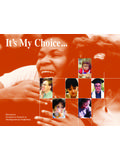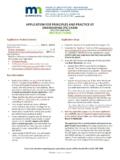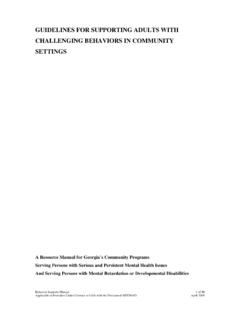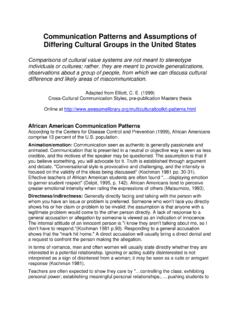Transcription of Concepts and Theory of Normalization
1 CHAPTER 30 Concepts and Theory ofNormalizationby WILLIAM G. BRONSTON, AND BACKGROUNDThe Essence of DehumanizationTo respondTo a significant degree ..To a human beingAs if he were not what he is ..Or could never be ..What he might beI am very deeply honored and feel privileged to be here to share thishistoric occasion with you. When the Down's Syndrome Congress wasborn last year, I had the very special sense, having attended that meeting,that you really represented the rebirth of something that happened inthe 50's when the then National Association for Retarded Children wasestablished. Then, people arose out of common need to defend theirrights and the rights of their sons and daughter's who had special was an inspiration, an enthusiasm, a militance in the 50's as anew social force came into being in this country a force to opposedehumanization, to oppose human abuse, to oppose second-class citizen-ship.
2 As the years have rolled on, two decades and a half since the found-ing of the National Association, there has been a quieting, a placidity,a loss of some of the inspiration in that movement at a time when weneed that inspiration and militance more than ever. I believe that yourepresent a resurgence of that, conviction and devotion and sacrificeThis chapter was presented to the Down's Syndrome Congress, Milwaukee. Wiscon-sin, September 30, 1974. It presents a valuable philosophical base for all and Theory of Normalization491to the common good based on very moral, deeply felt beliefs in theinterests of your sons and daughters who have Down's are not alone. Naturally, the question of the rights of preschoolage children is a binning issue. The preschool community represents aminority group in this country, demanding special and decent qualityservices for their special needs.
3 The Black, Chicano, and native Amer-ican communities are asserting their needs. The same is true of the el-derly, a national minority that is beginning to realize, little by little,that on a strategic level, they are destined to be institutionalized, anddie in loneliness, abandonment, misery, and dehumanization in the vastinstitutional program that is being erected for all citizens in theiradvanced years. Ladies and gentlemen, one out of three of you sittingin this room will die in an institution for the elderly if the present rateof construction of nursing homes continues and the ideology , the largest national minority, have also raised their concerns fora different kind of society. You, as representatives of another nationalminority, citizens with Down's Syndrome, will and must take your placealongside the other great national and historical movements whose ob-jectives include no less than survival in our culture, a better quality oflife, and social one group is devalued, all are devalued.
4 If one group is attacked,all groups will be attacked. I would like to bring to your attention apiece of legislation that was passed in Florida last year by the lowerhouse of the State Legislature, entitled "Death with Dignity." This riderwas attached to legislation entitled the "Sunshine Bill," a benefit pack-age for the elderly in Florida. The essence of "Death with Dignity" re-lated to a large number of people residing in the state's institutions forthe mentally retarded who were not considered citizens because theywere labeled severely and profoundly impaired. The bill proposed thatall life-supports be cut off from this labeled population. Fifteen hundredpeople would have been threatened in Florida had that bill passedthe State Senate. That bill may pass the Senate within the next fewyears.
5 After a bill is passed to exterminate those whom the bureaucracylabels profoundly retarded, who will be the next group that will beselected to be exterminated because they arc a burden, not worth theexpense, or lack advocates? In "Death with Dignity" regulations, thepriorities for extermination fell upon those people who did not have aparent, guardian, or advocate, and were in the , it is not elective that you are here concerned with yourrights, though you may feel that you have freely chosen to come. It is492 The Mentally Retarded Child and His Familyimperative that you are here! For as one group struggles for what is justand human, all groups who live at high risk outside the mainstreamwill is in this context that Normalization has to be studied and has four basic thrusts today:1.
6 The first is for consciousness-raising. Normalization will help usdislodge some of the prejudices and biases that both we and the generalsociety at large hold against people who are different. Unless we surfacethese massive, deeply held, often unconscious beliefs about differentness,as they are directed towards those labeled retarded in our society, we willmake very slow headway in transforming social Normalization is one of the most powerful organizing tools thathas developed in the human services scene for consumers and advocatesto marshall their strength and have a clear vision of where they aregoing and where human services ought to be Normalization is a fundamental tool to initially indoctrinate andtrain all potential human service workers .. physicians, nurses, thera-pists, teachers, administrators, anybody in the human services embarkingon their educational course.
7 Technology must derive from the normal-ization concerns, and not vice versa. Sadly, technology today, as we knowit, is so entrenched in attitudes and practices which dehumanize anddevalue people served that Normalization , taught apart from the corecurriculum, becomes rhetoric to cloak business as Finally, Normalization , or the socio-developmental model of growth,provides one of the most coherent and systematic ideologies to light theroad for all human services: a guide, a direction in an era of turmoil,arbitrary scientific innovation, grass roots disenfranchisement and moralbankruptcy of so many of our is a value-based set of principles. Whether or not wecan say scientifically or empirically that Normalization works betterthan other service approaches is a consequence of how we look at thingsthrough what we hold to be important, not, as some try to hold, objective"value-free" evidence or data.
8 What arc the values that underlie normal-ization? All human beings are special and precious. All human beings,like all living things, change constantly and grow. Everyone has theright and need to be loved, have a family, have intimates; each personhas the right to be productive, have an education, to have a comfortabledwelling and quality life-supports. These are values. We cannot provethat these work better than pitching people into institutions. That is aConcepts and Theory of Normalization493matter of value-based attitudes in ourselves and our culture. Normaliza-tion is therefore deeply rooted in culture and basic rationales for normalizing services are that devaluedpeople will be perceived and treated as: human beings, citizens, anddeveloping, adaptive and responsive would like to share with you some of the historical background ofnormalization.
9 Sonic key dates and highlights should suffice for ouroverview. In 1959, Denmark was the first nation which passed legisla-tion that established a unified agency concerned with the health, edu-cation, and welfare of people with special needs, specifically based onhelping them experience life as normally as possible. This attitudewas explicit in the legislation which confronted basic approaches. Wherethere had been a permissiveness toward institutions, there would now bea policy of providing home-like living arrangements for all persons need-ing residential services. Where there had been a domination of the"medical model" based on seeing people as sick or diseased, dependenton health technicians for assistance, the "educational-developmentalmodel" became the dominant approach.
10 Where people had been per-ceived as subhuman they would be emulated as citizens with segregation pervaded the public educational scene discriminatingagainst and separating children with special needs from the mainstream,integration would be a guiding principle and objective goal of the schoolsystem in a decade went by before Sweden passed a similar law in1967-68, creating an agency to unite service resources for retarded per-sons based on the Normalization principle. Then things began to Wolfensberger, Frank Menolascino and a small circle of co-workersmobilized a campaign in Nebraska, spreading over 2 or 3 years to focusefforts of the movement upon establishing a sweeping law that wouldbring all the elements of Normalization into a service system for personslabelled retarded.















![VL]HFKDUW H[SHUWWLSV](/cache/preview/3/f/0/8/6/2/e/b/thumb-3f0862eb9c0c2e569eb91edc1a39bed4.jpg)
